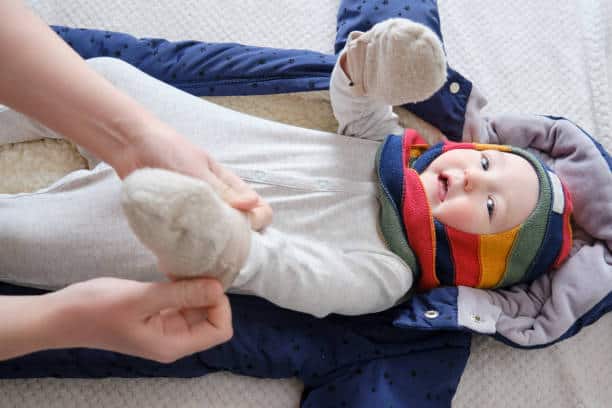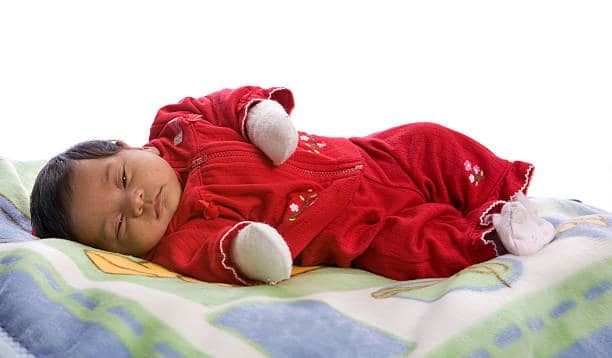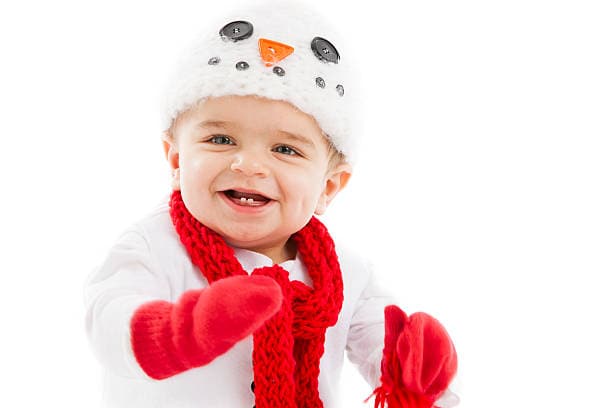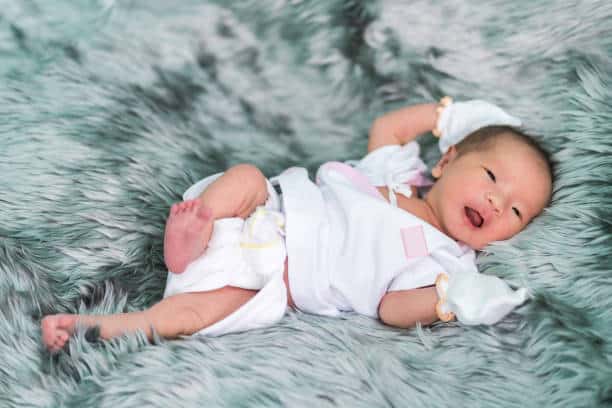Parents of newborns often face the challenge of keeping their little ones comfortable and safe. One common concern is how to protect their baby’s delicate skin from scratches.
This is where mittens come in handy. Mittens are an essential accessory for newborns, as they help prevent babies from accidentally scratching themselves with their sharp nails.
However, some parents may wonder if their 3 month old still wearing mittens.
While babies grow quickly, their motor skills take time to develop. At three months, most babies are still learning to control their movements, including their hand gestures.
This means they are still at risk of scratching themselves, especially during sleep or when they are upset. Therefore, it is essential to continue using mittens until the baby can control their movements and nails are trimmed.
However, there are several factors to consider when choosing the right mittens for your baby, such as materials, comfort, and safety. In this article, we will explore the need for mittens, their role in a baby’s development, and how to choose the best ones for your little one.

Key Takeaways
- Mittens are essential for newborns to protect their skin from accidental scratches.
- Babies at three months old still need to wear mittens as they are still learning to control their movements.
- When choosing mittens, consider the materials, comfort, and safety to ensure the best fit for your baby.
1. Understanding the Need for Mittens

Newborn babies have a lot of needs, and one of those needs is to be kept warm. This is especially important for their little hands, which can get cold easily.
That’s why many parents choose to put mittens on their babies to help keep them warm and comfortable.
Mittens for babies come in a variety of materials, including cotton and fleece. Cotton mittens are a popular choice because they are soft and breathable, which is important for a baby’s delicate skin.
Fleece mittens are also a good option for colder weather because they provide extra warmth.
In addition to keeping a baby’s hands warm, mittens can also help protect them from scratching themselves. Newborns often have sharp nails that can accidentally scratch their face or body.
By putting mittens on their hands, parents can help prevent these accidental scratches.
Choosing the right mittens for a baby can be a bit of a challenge. It’s important to find mittens that fit well and are comfortable for the baby to wear.
Mittens that are too tight can be uncomfortable and restrict movement, while mittens that are too loose can easily fall off.
Overall, mittens are an important part of a baby’s wardrobe. They help keep a baby warm, protect their delicate skin, and give parents a little more control over their baby’s needs.
2. The Role of Mittens in Baby’s Development

Mittens are an essential part of a baby’s wardrobe, especially during the first few months of their life. They play a crucial role in a baby’s development, providing comfort and protection to their delicate skin.
Babies are born with soft and delicate skin that requires extra care and attention. Mittens are made from soft materials that protect the baby’s fingers and hands from scratches and accidental injuries.
They also provide a sense of comfort to the baby, making them feel secure and safe.
During the first few months of their life, babies are curious and explore their surroundings with their fingers. Mittens help them in this process by allowing them to reach and touch objects without causing any harm to themselves.
This helps in the development of their fine motor skills and dexterity.
Mittens also play a crucial role during the transition from the womb to the outside world. Babies are born with a strong sense of touch, and mittens help in the development of their sensory skills.
They provide a gentle pressure on the baby’s hands, which stimulates their senses and helps in their sensory development.
It is important to note that every baby has individual needs, and some may require mittens for a longer period than others. As the baby grows and develops, their need for mittens may decrease, and they may start exploring their surroundings without them.
In conclusion, mittens are an essential part of a baby’s wardrobe during their first few months of life. They provide comfort, protection, and aid in the development of their fine motor skills and sensory development.
It is important to choose mittens made from soft materials that are gentle on the baby’s delicate skin.
3. Scratching and Skin Protection

Newborns have delicate skin that is easily scratched by sharp fingernails or objects around them. Scratching can cause irritation, discomfort, and even infection.
It is important to protect their skin from scratches, especially on their faces where they can easily scratch themselves.
One way to protect a newborn’s skin is to keep their nails trimmed short and filed smooth. However, this can be challenging as their nails grow quickly and are often sharp.
Another solution is to use protective mittens to cover their hands and prevent them from scratching their faces.
Protective mittens are made of soft, breathable fabric that is gentle on a newborn’s delicate skin. They are designed to fit snugly over their hands and stay in place, so they cannot be easily removed.
Mittens can also help keep a newborn’s hands warm and cozy.
While mittens can be effective in preventing scratches, it is important to note that they should not be worn all the time. Newborns need to explore and touch objects around them to learn and develop their senses.
Wearing mittens for long periods can hinder their development and may cause discomfort.
In summary, scratching can cause discomfort, irritation, and infection to a newborn’s delicate skin. Protective mittens can be an effective solution to prevent scratching, especially on their faces.
However, they should not be worn all the time to allow for exploration and development. Keeping nails trimmed short and filed smooth can also help prevent scratching.
4. Materials and Comfort

When it comes to keeping a 3-month-old baby warm, the materials used for clothing are crucial. Mittens are an essential part of a baby’s outfit during colder months, and it is important to choose the right materials to ensure maximum comfort and warmth.
Cotton mittens are a popular choice for newborns and infants as they are soft and gentle on the skin. They are also breathable, which prevents overheating and sweating. Wool mittens, on the other hand, are great for colder temperatures as they are naturally warm and insulating.
However, wool can be itchy and uncomfortable for some babies, so it is important to choose a soft and high-quality wool material.
Fleece mittens are another option for colder weather as they are soft, warm, and lightweight. They are also easy to clean and maintain.
When it comes to designs, mittens with a snug fit are recommended as they prevent cold air from entering and keep the baby’s hands warm. Mittens with adjustable straps or cuffs are also great as they ensure a secure fit and prevent them from falling off.
Overall, the comfort of the baby should always be the top priority when choosing materials for mittens. Cotton, wool, and fleece are all great options for warmth and comfort.
It is important to choose materials that are soft, breathable, and gentle on the skin.
5. Safety Concerns and Precautions

When it comes to dressing infants, parents often wonder whether mittens are a necessity. While there are advantages to infants wearing mittens, there are also some safety concerns and precautions that parents should be aware of.
Firstly, mittens can pose a choking hazard if they are not fitted properly. If the mittens are too loose, they can slip off and end up in the baby’s mouth.
This can result in choking or gagging. It is important to ensure that the mittens fit snugly and do not slip off easily.
Another safety concern is that mittens can interfere with the baby’s grip and ability to hold objects. This can hinder their development and exploration of the world around them.
Pediatricians recommend that infants be allowed to explore their environment freely and without any hindrances.
Additionally, mittens can cause discomfort and irritation to the baby’s skin, especially if they are made of synthetic materials. If the baby has eczema or any other medical condition that affects the skin, it is best to avoid using mittens altogether.
Instead, parents can opt for alternative ways to keep the baby’s hands warm, such as using blankets or warm clothing.
To ensure the safety of infants wearing mittens, parents should follow some precautions. Firstly, they should always supervise the baby while they are wearing mittens.
Secondly, they should ensure that the mittens are fitted properly and not too tight or too loose. Lastly, they should check the mittens regularly for any signs of wear and tear, and replace them if necessary.
In conclusion, while there are benefits to infants wearing mittens, parents should also be aware of the safety concerns and precautions. By following these guidelines, parents can ensure that their baby stays safe and comfortable while wearing mittens.
For more information, parents can visit healthychildren.org or consult with their pediatrician.
6. Keeping Baby Warm

It is important to keep your baby warm during cold weather to prevent them from getting sick. One way to do this is by ensuring their hands are kept warm, especially for newborns and infants.
Mittens are a great way to achieve this.
When selecting mittens for your baby, it is important to choose materials that are warm and soft. Materials such as cotton, fleece, and wool are great options.
These materials will keep your baby’s hands warm while also being gentle on their delicate skin.
It is also important to ensure that your baby’s clothes are warm enough. Onesies are a great option for layering and keeping your baby warm.
You can also add a sweater or jacket on top of the onesie for extra warmth.
When dressing your baby, it is important to not overdress them. Overdressing can cause your baby to overheat, which can be dangerous.
A good rule of thumb is to dress your baby in one more layer than you would wear in the same weather.
In addition to mittens, you can also use blankets to keep your baby warm. Swaddling your baby in a warm blanket can help them feel cozy and secure.
Just be sure to not cover their face or head with the blanket.
Overall, keeping your baby warm during cold weather is important for their health and comfort. By choosing warm materials, dressing your baby appropriately, and using mittens and blankets, you can help ensure your baby stays warm and cozy.
Frequently Asked Questions
How long should newborns wear mittens?
Newborns should wear mittens for the first few weeks after birth. This is because they have a strong startle reflex and may accidentally scratch their face with their sharp nails. After the first few weeks, it is safe to stop using mittens, but some babies may continue to wear them for longer.
Are there any cons to using baby mittens?
While baby mittens can be useful in preventing scratches, they can also pose some risks. Mittens can cause babies to overheat, which can be dangerous. Additionally, mittens can make it difficult for babies to explore and learn about their environment through touch.
How many baby mittens should I have on hand?
It is recommended to have at least 4-6 pairs of baby mittens on hand. This allows for frequent washing and replacement as needed.
When should I stop covering my baby’s hands at night?
It is safe to stop covering your baby’s hands at night once they are able to control their movements and no longer have a strong startle reflex. This usually occurs around 3-4 months of age.
Is it true that baby mittens can hinder development?
There is no evidence to suggest that baby mittens can hinder development. However, it is important to allow babies to explore their environment through touch in order to promote healthy development.
Why is it not recommended to put mittens on a baby’s hands?
Putting mittens on a baby’s hands can prevent them from exploring and learning about their environment through touch. It can also cause them to overheat, which can be dangerous. Additionally, mittens can make it difficult for babies to grasp and hold objects, which can hinder their development.

Iesha is a loving mother of 2 beautiful children. She’s an active parent who enjoys indoor and outdoor adventures with her family. Her mission is to share practical and realistic parenting advice to help the parenting community becoming stronger.
